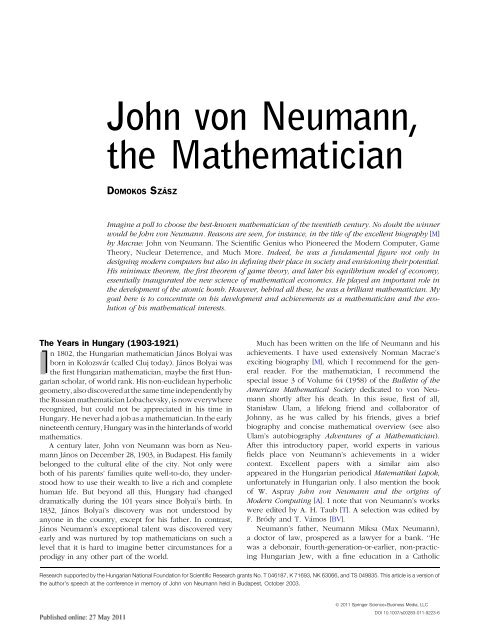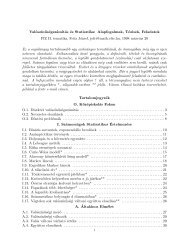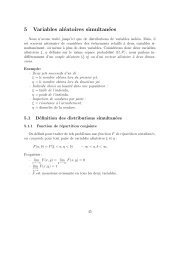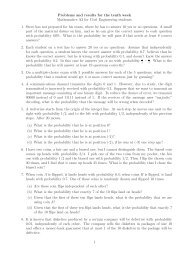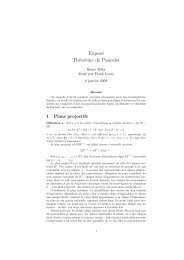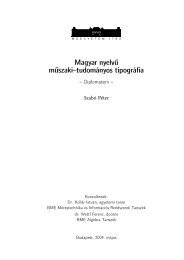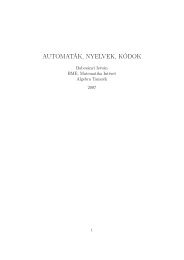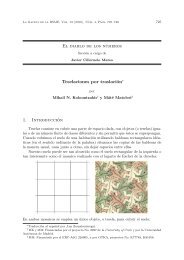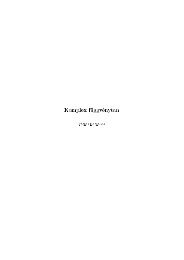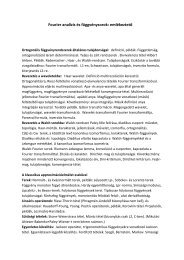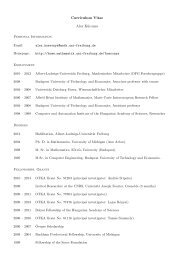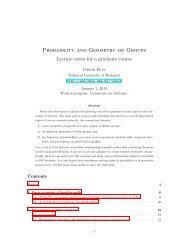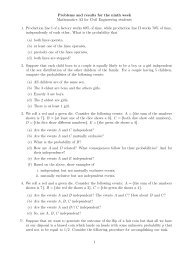John von Neumann, the Mathematician
John von Neumann, the Mathematician
John von Neumann, the Mathematician
Create successful ePaper yourself
Turn your PDF publications into a flip-book with our unique Google optimized e-Paper software.
<strong>John</strong> <strong>von</strong> <strong>Neumann</strong>,<br />
<strong>the</strong> Ma<strong>the</strong>matician<br />
DOMOKOS SZÁSZ<br />
Imagine a poll to choose <strong>the</strong> best-known ma<strong>the</strong>matician of <strong>the</strong> twentieth century. No doubt <strong>the</strong> winner<br />
would be <strong>John</strong> <strong>von</strong> <strong>Neumann</strong>. Reasons are seen, for instance, in <strong>the</strong> title of <strong>the</strong> excellent biography [M]<br />
by Macrae: <strong>John</strong> <strong>von</strong> <strong>Neumann</strong>. The Scientific Genius who Pioneered <strong>the</strong> Modern Computer, Game<br />
Theory, Nuclear Deterrence, and Much More. Indeed, he was a fundamental figure not only in<br />
designing modern computers but also in defining <strong>the</strong>ir place in society and envisioning <strong>the</strong>ir potential.<br />
His minimax <strong>the</strong>orem, <strong>the</strong> first <strong>the</strong>orem of game <strong>the</strong>ory, and later his equilibrium model of economy,<br />
essentially inaugurated <strong>the</strong> new science of ma<strong>the</strong>matical economics. He played an important role in<br />
<strong>the</strong> development of <strong>the</strong> atomic bomb. However, behind all <strong>the</strong>se, he was a brilliant ma<strong>the</strong>matician. My<br />
goal here is to concentrate on his development and achievements as a ma<strong>the</strong>matician and <strong>the</strong> evolution<br />
of his ma<strong>the</strong>matical interests.<br />
The Years in Hungary (1903-1921)<br />
In 1802, <strong>the</strong> Hungarian ma<strong>the</strong>matician János Bolyai was<br />
born in Kolozsvár (called Cluj today). János Bolyai was<br />
<strong>the</strong> first Hungarian ma<strong>the</strong>matician, maybe <strong>the</strong> first Hungarian<br />
scholar, of world rank. His non-euclidean hyperbolic<br />
geometry, also discovered at <strong>the</strong> same time independently by<br />
<strong>the</strong> Russian ma<strong>the</strong>matician Lobachevsky, is now everywhere<br />
recognized, but could not be appreciated in his time in<br />
Hungary. He never had a job as a ma<strong>the</strong>matician. In <strong>the</strong> early<br />
nineteenth century, Hungary was in <strong>the</strong> hinterlands of world<br />
ma<strong>the</strong>matics.<br />
A century later, <strong>John</strong> <strong>von</strong> <strong>Neumann</strong> was born as <strong>Neumann</strong><br />
János on December 28, 1903, in Budapest. His family<br />
belonged to <strong>the</strong> cultural elite of <strong>the</strong> city. Not only were<br />
both of his parents’ families quite well-to-do, <strong>the</strong>y understood<br />
how to use <strong>the</strong>ir wealth to live a rich and complete<br />
human life. But beyond all this, Hungary had changed<br />
dramatically during <strong>the</strong> 101 years since Bolyai’s birth. In<br />
1832, János Bolyai’s discovery was not understood by<br />
anyone in <strong>the</strong> country, except for his fa<strong>the</strong>r. In contrast,<br />
János <strong>Neumann</strong>’s exceptional talent was discovered very<br />
early and was nurtured by top ma<strong>the</strong>maticians on such a<br />
level that it is hard to imagine better circumstances for a<br />
prodigy in any o<strong>the</strong>r part of <strong>the</strong> world.<br />
Much has been written on <strong>the</strong> life of <strong>Neumann</strong> and his<br />
achievements. I have used extensively Norman Macrae’s<br />
exciting biography [M], which I recommend for <strong>the</strong> general<br />
reader. For <strong>the</strong> ma<strong>the</strong>matician, I recommend <strong>the</strong><br />
special issue 3 of Volume 64 (1958) of <strong>the</strong> Bulletin of <strong>the</strong><br />
American Ma<strong>the</strong>matical Society dedicated to <strong>von</strong> <strong>Neumann</strong><br />
shortly after his death. In this issue, first of all,<br />
Stanisław Ulam, a lifelong friend and collaborator of<br />
<strong>John</strong>ny, as he was called by his friends, gives a brief<br />
biography and concise ma<strong>the</strong>matical overview (see also<br />
Ulam’s autobiography Adventures of a Ma<strong>the</strong>matician).<br />
After this introductory paper, world experts in various<br />
fields place <strong>von</strong> <strong>Neumann</strong>’s achievements in a wider<br />
context. Excellent papers with a similar aim also<br />
appeared in <strong>the</strong> Hungarian periodical Matematikai Lapok,<br />
unfortunately in Hungarian only. I also mention <strong>the</strong> book<br />
of W. Aspray <strong>John</strong> <strong>von</strong> <strong>Neumann</strong> and <strong>the</strong> origins of<br />
Modern Computing [A]. I note that <strong>von</strong> <strong>Neumann</strong>’s works<br />
were edited by A. H. Taub [T]. A selection was edited by<br />
F. Bródy and T. Vámos [BV].<br />
<strong>Neumann</strong>’s fa<strong>the</strong>r, <strong>Neumann</strong> Miksa (Max <strong>Neumann</strong>),<br />
a doctor of law, prospered as a lawyer for a bank. ‘‘He<br />
was a debonair, fourth-generation-or-earlier, non-practicing<br />
Hungarian Jew, with a fine education in a Catholic<br />
Research supported by <strong>the</strong> Hungarian National Foundation for Scientific Research grants No. T 046187, K 71693, NK 63066, and TS 049835. This article is a version of<br />
<strong>the</strong> author’s speech at <strong>the</strong> conference in memory of <strong>John</strong> <strong>von</strong> <strong>Neumann</strong> held in Budapest, October 2003.<br />
Ó 2011 Springer Science+Business Media, LLC<br />
DOI 10.1007/s00283-011-9223-6
provincial high-school. He was well attuned to fin-de-siècle<br />
Austria-Hungary and indeed to being a lively intellectual in<br />
any age. His party piece was to compose two-line ditties<br />
about <strong>the</strong> latest vicissitudes of his personal or business life,<br />
and about national and international politics.’’ 1 Jacob Kann,<br />
<strong>Neumann</strong>’s grandfa<strong>the</strong>r through his mo<strong>the</strong>r Kann Margit<br />
(Margaret Kann), ‘‘was a distinctly prosperous man. With a<br />
partner, he had built up in Budapest a thriving business in<br />
agricultural equipment that grew even faster in 1880-1914<br />
than Hungary’s <strong>the</strong>n soaring GNP.’’ The Kanns owned a<br />
ra<strong>the</strong>r big and nice house close to <strong>the</strong> Hungarian Parliament<br />
on <strong>the</strong> so-called Kiskörút, Small Boulevard. The<br />
Kanns and later <strong>the</strong> families of <strong>the</strong>ir four daughters lived<br />
<strong>the</strong>re, while <strong>the</strong> ground floor was occupied by <strong>the</strong> firm<br />
Kann-Heller. When <strong>the</strong> families grew larger, <strong>the</strong>y also<br />
rented <strong>the</strong> neighboring house. János’s mo<strong>the</strong>r Margit was<br />
‘‘a mo<strong>the</strong>r hen tending her children and protecting <strong>the</strong>m.<br />
She was a family woman, a good deal less rigorous than her<br />
husband, artistically inclined, a wafer-thin and later chainsmoking<br />
enthusiast for comporting oneself with what she<br />
called ‘elegance’ (which later became <strong>Neumann</strong>’s highest<br />
term of praise for neat ma<strong>the</strong>matical calculations such as<br />
<strong>the</strong> ones that made <strong>the</strong> H-bomb possible).’’<br />
Max and Margaret had three children, of which <strong>John</strong>ny<br />
was <strong>the</strong> oldest. ‘‘Grandfa<strong>the</strong>r Jacob Kann had gone straight<br />
.........................................................................<br />
AUTHOR<br />
DOMOKOS SZÁSZ is a student of A.<br />
Prékopa, A. Rényi, B. V. Gnedenko, and Ya.<br />
G. Sinai. He founded <strong>the</strong> Budapest schools in<br />
ma<strong>the</strong>matical statistical physics and dynamical<br />
systems. His current ambition is <strong>the</strong> rigorous<br />
derivation of laws of statistical physics<br />
(diffusion, heat conduction) from microscopic<br />
assumptions. His o<strong>the</strong>r enthusiasms are his<br />
family (three children, two grandchildren),<br />
culture, and skiing.<br />
Ma<strong>the</strong>matical Institute<br />
Budapest University of Technology and<br />
Economics<br />
H-1111 Budapest<br />
Hungary<br />
from commercial high school into founding his business,<br />
but he proved demonic in his capacity for arithmetic<br />
manipulation. He could add in his head monstrous columns<br />
of numbers or multiply mentally two numbers in <strong>the</strong><br />
thousands or even millions. The six-year-old <strong>John</strong>ny would<br />
laboriously perform <strong>the</strong> computations with pencil and<br />
paper, and announce with glee that Grandfa<strong>the</strong>r had been<br />
absolutely on <strong>the</strong> mark. Later <strong>John</strong>ny himself was known<br />
for his facility in mental computation, but he had long<br />
before persuaded himself that he could never match<br />
Jacob’s level of multiplication skill.’’<br />
‘‘Nursemaids, governesses and preschool teachers were<br />
an integral part of upper-middle-class European households<br />
in those days, especially in countries where (as in<br />
Hungary) children in such families did not start school until<br />
age ten. As <strong>the</strong> Kann grandchildren and some of <strong>John</strong>ny’s<br />
second cousins came along, <strong>the</strong> building on <strong>the</strong> Small<br />
Boulevard became an educational institution in its own<br />
right. There was an especially early emphasis on learning<br />
foreign languages. Fa<strong>the</strong>r Max thought that youngsters who<br />
spoke only Hungarian would not merely fail in <strong>the</strong> Central<br />
Europe <strong>the</strong>n darkening around <strong>the</strong>m, <strong>the</strong>y might not even<br />
survive.’’ So <strong>John</strong>ny (or Jancsi in Hungarian) learned German,<br />
French, English, and Italian from various governesses<br />
from abroad. <strong>John</strong>ny later told colleagues in Princeton that<br />
as a six-year-old he would converse with his fa<strong>the</strong>r in<br />
classical Greek. This seems to have been a joke, but his<br />
knowledge of languages was real. It not only made his<br />
communication easier in Germany, Zürich, and in <strong>the</strong> US,<br />
but it may have imprinted at an early age axiomatic and<br />
abstract, algorithmic thinking into his brain.<br />
In such an environment, young <strong>John</strong>ny was easily<br />
drinking in <strong>the</strong> knowledge surrounding him. One of his<br />
special interests was history: The family bought ‘‘an entire<br />
library, whose centerpiece was <strong>the</strong> Allgemeine Geschichte<br />
by Wilhelm Oncken. <strong>John</strong>ny ploughed through all fortyfour<br />
volumes. Bro<strong>the</strong>r Michael was confounded by <strong>the</strong> fact<br />
that what <strong>John</strong>ny read, <strong>John</strong>ny remembered. Decades later<br />
friends were startled to discover that he remembered still.’’<br />
Between 1914 and 1921, <strong>John</strong>ny attended <strong>the</strong> Lu<strong>the</strong>ran<br />
Gymnasium in Budapest. Here, too, he received a superb<br />
education. This was made possible by <strong>the</strong> fast economic<br />
and social progress after <strong>the</strong> compromise with Austria 2 and<br />
subsequent cultural and educational reforms. 3<br />
1 Here and below, many unattributed quotes are from [M].<br />
2 Some data from <strong>the</strong> late nineteenth-century history of Hungary. 1867: Appeasement with Austria and <strong>the</strong> formation of <strong>the</strong> Austro-Hungarian Monarchy after <strong>the</strong><br />
defeat of <strong>the</strong> 1848 revolution. 1873: Formation of <strong>the</strong> city Budapest from smaller cities such as Buda and Pest. In <strong>the</strong> years afterward, Hungary and Budapest<br />
experienced extremely fast economic, social, and intellectual progress. Society was quite open, with ‘‘a flood of Jewish immigration into Hungary in <strong>the</strong> 1880s and<br />
1890s as <strong>the</strong>re was simultaneously to New York.’’ In 1896 a World Exposition was held in Budapest also commemorating <strong>the</strong> arrival of Hungarians to <strong>the</strong> Carpathians<br />
in 896. Hausmann-like reconstruction of <strong>the</strong> city contributed to its present character. For instance, <strong>the</strong> first subway of <strong>the</strong> European continent was inaugurated in 1896<br />
in Budapest. ‘‘In 1903 <strong>the</strong> Elisabeth Bridge over <strong>the</strong> Danube was <strong>the</strong> longest single span bridge in <strong>the</strong> world.’’ For <strong>the</strong> interested reader I strongly recommend <strong>the</strong> book<br />
of <strong>John</strong> Lukacs [Luk].<br />
3 Some data from <strong>the</strong> nineteenth-century cultural progress of Hungary. End of nineteenth and first half of twentieth century: Development of national thought and<br />
nationalistic institutions, in particular, <strong>the</strong> foundation of <strong>the</strong> National Museum and <strong>the</strong> Hungarian Academy of Sciences. After <strong>the</strong> Appeasement of 1867, <strong>the</strong> educational<br />
system was transformed and modernized. (For some time <strong>the</strong> Minister of Education was Loránd Eötvös, <strong>the</strong> famous physicist, inventor of <strong>the</strong> torsion pendulum). The<br />
Gazette of Sciences, called today World of Nature, was founded in 1869, that is, in <strong>the</strong> same year as <strong>the</strong> magazine Nature in Britain! The Ma<strong>the</strong>matical and Physical<br />
Society was founded in 1891. (Since 1947 <strong>the</strong>re are separate societies for Ma<strong>the</strong>matics and Physics, called <strong>the</strong> János Bolyai and <strong>the</strong> Loránd Eötvös Societies,<br />
respectively; in 1968 <strong>the</strong> <strong>John</strong> <strong>von</strong> <strong>Neumann</strong> Computer Society was founded.) In 1894 Dániel Arany founded <strong>the</strong> Középiskolai Matematikai Lapok, <strong>the</strong> oldest journal for<br />
high-school students; this journal still flourishes in an extended form including physics. In <strong>the</strong> same year 1894, <strong>the</strong> first Ma<strong>the</strong>matical and Physical Competitions started<br />
(today <strong>the</strong> ma<strong>the</strong>matical competitions are called József Kürschák Competitions).<br />
THE MATHEMATICAL INTELLIGENCER
As a result of <strong>the</strong>se reforms <strong>the</strong> whole educational system<br />
was strong; for <strong>the</strong> talented (and let us also add,<br />
wealthy) pupils, <strong>the</strong>re were élite high-schools. One of <strong>the</strong>m<br />
was <strong>the</strong> Lu<strong>the</strong>ran Gymnasium. It was quite liberal and had<br />
a number of Jewish pupils. Nobel Prize winners E. Wigner<br />
and later J. Harsányi also attended this high-school. As a<br />
matter of fact, Wigner studied a year above <strong>Neumann</strong>, and<br />
already at school a respect and a friendship were formed<br />
between <strong>the</strong> two.<br />
<strong>John</strong>ny’s teacher of ma<strong>the</strong>matics was <strong>the</strong> celebrated László<br />
Rátz. Between 1896 and 1914, he was <strong>the</strong> chief editor of <strong>the</strong><br />
high-school journal Középiskolai Matematikai Lapok. ‘‘Wigner<br />
and o<strong>the</strong>rs recall that Rátz’s recognition of <strong>John</strong>ny’s<br />
ma<strong>the</strong>matical talent was instant.’’ Rátz agreed with Max <strong>Neumann</strong><br />
that <strong>John</strong>ny would be supervised by professional<br />
ma<strong>the</strong>maticians from <strong>the</strong> universities. Thus Professor J. Kurschak<br />
(Kürschák József) from Technical University arranged<br />
that <strong>John</strong>ny would be tutored by <strong>the</strong> young G. Szego (Szeg}o<br />
Gábor) in 1915–1916. Later he was also taught by M. Fekete<br />
(Fekete Mihály) and Leopold Fejér (FejérLipót), and could<br />
also talk to A. Haar (Haar Alfréd) and Frédéric Riesz (Riesz<br />
Frigyes). All in all, <strong>the</strong> prodigy received education and<br />
supervision on <strong>the</strong> highest professional and intellectual level.<br />
In <strong>the</strong> years 1919–1921, when <strong>von</strong> <strong>Neumann</strong> graduated<br />
from <strong>the</strong> Lu<strong>the</strong>ran Gymnasium, <strong>the</strong> ma<strong>the</strong>matical competition<br />
for secondary schools did not take place because of<br />
<strong>the</strong> revolution in Hungary; but in 1918, <strong>Neumann</strong> was<br />
permitted to sit in as an unofficial participant, and would<br />
have won <strong>the</strong> first prize. The list of winners of <strong>the</strong> ma<strong>the</strong>matical<br />
competitions before 1928 include among o<strong>the</strong>rs L.<br />
Fejér, Th. <strong>von</strong> Kármán, D. Konig, A. Haar, M. Riesz, G.<br />
Szego, and E. Teller, whereas L. Szilárd won a second prize.<br />
It is commonplace that around and shortly after <strong>the</strong> turn<br />
of <strong>the</strong> nineteenth and twentieth centuries Hungary exported<br />
a tremendous amount of brains to <strong>the</strong> West besides <strong>von</strong><br />
<strong>Neumann</strong>, but it may be worth listing some of <strong>the</strong>se scientists:<br />
Dennis Gabor (Gábor Dénes; Nobel Prize 1971),<br />
<strong>John</strong> Harsányi (Harsányi János; Nobel Prize 1994), Georg<br />
<strong>von</strong> Hevesy (Hevesy György; Nobel Prize 1943), Theodore<br />
<strong>von</strong> Kármán (KármánTódor), Nicholas Kurti (Kürti Miklós),<br />
Cornelius Lanczos (Lánczos Kornél), Peter Lax (Lax Péter;<br />
Wolf Prize 1987), George Olah (Oláh György; Nobel Prize<br />
1994), Michael Polanyi (Polányi Mihály), George Pólya<br />
(Pólya György), Gabor Szego (Szeg}o Gábor), Albert Szent-<br />
Györgyi (Szent-Györgyi Albert; Nobel Prize 1937), Leo<br />
Szilárd (Szilárd Leó), Edward Teller (Teller Ede), Eugene<br />
Wigner (Wigner Jenö; Nobel Prize 1963), and Aurel Friedrich<br />
Wintner. One might wonder about <strong>the</strong> ‘‘<strong>von</strong>’’s figuring<br />
in several of <strong>the</strong>se names. Macrae explains <strong>the</strong> case of<br />
<strong>Neumann</strong>: ‘‘In 1913 <strong>the</strong> forty-three-year-old Max was<br />
rewarded for his services to <strong>the</strong> government: he received<br />
<strong>the</strong> noble placename Margittai with hereditary nobility, so<br />
that in German he and his descendants could be called ‘<strong>von</strong><br />
<strong>Neumann</strong>.’ Ennoblement was not an unusual award for<br />
prominent bankers and industrialists during those last years<br />
of <strong>the</strong> Austro-Hungarian Empire. Many of <strong>the</strong> 220 Hungarian<br />
Jewish families who were ennobled in 1900–1914<br />
(vs. just over half of that number in <strong>the</strong> whole century<br />
before) hastened to change <strong>the</strong>ir names. Ennoblement was<br />
a way through which one could seize <strong>the</strong> chance to call<br />
The house on Kiskörút today. (Photo by Domokos Szász)<br />
himself less Jewish. Max <strong>Neumann</strong> deliberately did not<br />
change his name.’’<br />
The Ma<strong>the</strong>matics of <strong>John</strong> <strong>von</strong> <strong>Neumann</strong><br />
My aim here should certainly be quite modest, and I can go<br />
into a detailed description nei<strong>the</strong>r of his achievements nor<br />
of <strong>the</strong>ir influence. My goal is to follow some of <strong>the</strong> main<br />
and continuing interests of <strong>John</strong> <strong>von</strong> <strong>Neumann</strong>. The<br />
selection of <strong>the</strong>se interests is subjective and reflects my<br />
knowledge and judgement.<br />
Despite <strong>the</strong> breadth of his interests, <strong>the</strong> picture is not as<br />
complicated as it looks at first glance. This is especially true<br />
for <strong>the</strong> years before <strong>the</strong> War. It seems he usually had one<br />
main interest, and thought about o<strong>the</strong>r problems with <strong>the</strong><br />
left hand, so to speak. This does not mean that <strong>the</strong> o<strong>the</strong>r<br />
results are less important, only that even a genius is subject<br />
to laws of nature. If one wants to reach repeated breakthroughs<br />
in a problem or more than one (cf. Poincaré),<br />
<strong>the</strong>n a necessary condition is full concentration on it for<br />
quite a period. In short, <strong>the</strong> genius is known both by <strong>the</strong><br />
difficulty of <strong>the</strong> problems he can solve with full concentration,<br />
and by <strong>the</strong> difficulty of <strong>the</strong> problems he can solve<br />
with perhaps less persistent concentration.<br />
Axiomatic Set Theory<br />
In <strong>the</strong> first part of this paper I emphasized that this exceptional<br />
prodigy received an optimal launch in Hungary. In<br />
addition, one should note that <strong>the</strong> excellent ma<strong>the</strong>matical<br />
support in Budapest ensured his start as a scholar and as a<br />
researcher. Apart from his first paper with Fekete, his big<br />
interest was <strong>the</strong> axiomatization of set <strong>the</strong>ory. It is most likely<br />
that he heard about this problem from a tutor in Budapest.<br />
Julius König (König Gyula) (<strong>the</strong> fa<strong>the</strong>r of <strong>the</strong> graph-<strong>the</strong>oretician<br />
Denes König (König Dénes)) was himself also working<br />
on set <strong>the</strong>ory, and in particular on <strong>the</strong> continuum hypo<strong>the</strong>sis,<br />
but he died in 1913, before <strong>Neumann</strong> entered high-school.<br />
Anyway, ma<strong>the</strong>maticians in Budapest were definitely aware<br />
of this circle of problems (J. Kurschak, <strong>Neumann</strong>’s mentor,<br />
for instance, was a colleague of J. König). Macrae writes:<br />
‘‘The second of <strong>John</strong>ny’s papers (about transfinite ordinals)<br />
had been prepared while he was still in high-school in 1921,<br />
although it was not published until 1923’’(see [vN23]).<br />
Ó 2011 Springer Science+Business Media, LLC
The young <strong>Neumann</strong> János. (Photo from http://www.ysfine.<br />
com.wigner/neum/ymath.jpeg)<br />
His papers on set <strong>the</strong>ory and logic were published in<br />
1923 (1), 1925 (1), 1927 (1), 1928 (2), 1929 (1), and 1931<br />
(2). It is known that when he read about Gödel’s undecidability<br />
<strong>the</strong>orem in 1931, he dropped thinking seriously<br />
about this field. But <strong>the</strong>re was ano<strong>the</strong>r reason for that, too:<br />
starting at <strong>the</strong> latest from his scholarship in Göttingen in<br />
1926, his main interest had changed: it became centered<br />
around laying down <strong>the</strong> ma<strong>the</strong>matical foundations of<br />
quantum mechanics and hence around functional analysis.<br />
Ma<strong>the</strong>matical Foundations of Quantum Physics<br />
Hilbert certainly heard about <strong>the</strong> Hungarian Wunderkind<br />
quite early, and highly respected his results on set <strong>the</strong>ory and<br />
on Hilbert’s proof <strong>the</strong>ory. But in <strong>the</strong> mid-twenties, and very<br />
much in Göttingen, quantum mechanics was in <strong>the</strong> center of<br />
attention. Hilbert himself was strongly attracted to this disputed<br />
science. One should not forget that Göttingen was a<br />
center of quantum mechanics: Max Born (Nobel Prize 1954)<br />
and J. Franck (Nobel Prize 1925) were professors <strong>the</strong>re<br />
between 1921 and 1933 and between 1920 and 1933,<br />
respectively, and W. Heisenberg (Nobel Prize 1932) and W.<br />
Pauli (Nobel Prize 1945) also spent some years <strong>the</strong>re. In 1927,<br />
a long and important paper [HNvN27] on foundations of<br />
quantum mechanics of <strong>Neumann</strong> with Hilbert and L. Nordheim<br />
appeared. It also formulated a program that was later<br />
carried out in <strong>von</strong> <strong>Neumann</strong>’s book [vN32b].<br />
The program became a success story in many ways. It<br />
meant a victory for <strong>the</strong> Hilbert-space approach. Moreover,<br />
it attracted <strong>the</strong> attention of ma<strong>the</strong>maticians to <strong>the</strong> <strong>the</strong>ory of<br />
operators and to functional analysis. Also, by translating <strong>the</strong><br />
problems of quantum physics to <strong>the</strong> language of ma<strong>the</strong>matics,<br />
it formulated intriguing questions, which ei<strong>the</strong>r<br />
arose in physics or were generated by <strong>the</strong>m by <strong>the</strong> usual<br />
process of ma<strong>the</strong>matics. A substantial result of <strong>von</strong> <strong>Neumann</strong><br />
was <strong>the</strong> spectral <strong>the</strong>ory of unbounded operators,<br />
generalizing that given by Hilbert for bounded operators.<br />
Also, <strong>the</strong> language of operator <strong>the</strong>ory helped to reconcile<br />
<strong>the</strong> complementary and—apparently contradictory—<br />
approaches of Heisenberg and of Schrödinger.<br />
Von <strong>Neumann</strong>’s papers on <strong>the</strong> ma<strong>the</strong>matical foundations<br />
of quantum mechanics and functional analysis appeared in<br />
1927 (4), 1928 (5), 1929 (6), 1931 (2), 1932 (2), 1934 (2),<br />
1935 (3), and 1936 (1). I add that physicists appreciate, in<br />
particular, his <strong>the</strong>ories of hidden variables (more exactly, his<br />
proof of <strong>the</strong>ir nonexistence), of quantum logic, and of <strong>the</strong><br />
measuring process (cf. Geszti’s article in [BV]). From <strong>the</strong><br />
physical and also from gnoseological point of view I stress<br />
his disproof of <strong>the</strong> existence of hidden variables. The laws<br />
of quantum physics are by <strong>the</strong>ir very nature stochastic,<br />
basically contrary to <strong>the</strong> deterministic Laplacian view of <strong>the</strong><br />
universe. Several scholars, including Albert Einstein (his<br />
saying ‘‘God does not throw dice’’ became famous), did not<br />
accept a nondeterministic universe. There was a belief that<br />
probabilistic laws are always superficial and that behind<br />
<strong>the</strong>m <strong>the</strong>re must be some hidden variables, by <strong>the</strong> use of<br />
which <strong>the</strong> world becomes deterministic. This belief was<br />
irreversibly repudiated by <strong>von</strong> <strong>Neumann</strong>. 4<br />
Von <strong>Neumann</strong> writes in 1947 in an article entitled The<br />
Ma<strong>the</strong>matician [vN47], ‘‘It is undeniable that some of <strong>the</strong><br />
best inspirations of ma<strong>the</strong>matics—in those parts of it which<br />
are as pure ma<strong>the</strong>matics as one can imagine—have come<br />
from <strong>the</strong> natural sciences.’’ It is certainly undeniable that<br />
having shown ‘‘his lion’s claws’’ in set <strong>the</strong>ory, <strong>Neumann</strong> got<br />
to <strong>the</strong> right place: To elaborate <strong>the</strong> ma<strong>the</strong>matical foundations<br />
of quantum mechanics was <strong>the</strong> best imaginable<br />
challenge for <strong>the</strong> young genius. The completion of this task<br />
led to a victorious period for functional analysis, <strong>the</strong> <strong>the</strong>ory<br />
of unbounded operators. Von <strong>Neumann</strong> kept up this<br />
interest until his death. Peter Lax remembers, ‘‘I recall how<br />
pleased and excited <strong>Neumann</strong> was in 1953 when he<br />
learned of Kato’s proof of <strong>the</strong> self-adjointness of <strong>the</strong><br />
Schrödinger operator for <strong>the</strong> helium atom.’’ [Lax].<br />
Von <strong>Neumann</strong>, being a true ma<strong>the</strong>matician, was also<br />
aware of <strong>the</strong> o<strong>the</strong>r fundamental motivation of a ma<strong>the</strong>matician.<br />
In <strong>the</strong> same 1947 article [27] he starts, ‘‘I think it is a<br />
relatively good approximation to truth ... that ma<strong>the</strong>matical<br />
ideas originate in empirics, although <strong>the</strong> genealogy is<br />
sometimes long and obscure.’’ Then he continues, ‘‘But,<br />
once <strong>the</strong>y are so conceived, <strong>the</strong> subject begins to live a<br />
peculiar life of his own and is better compared to a creative<br />
one, governed by almost entirely aes<strong>the</strong>tical motivations,<br />
than to anything else and, in particular, to an empirical science.’’<br />
I can not resist adding one more idea of <strong>von</strong><br />
<strong>Neumann</strong> about his favourite criterion of elegance: ‘‘One<br />
expects from a ma<strong>the</strong>matical <strong>the</strong>orem or from a ma<strong>the</strong>matical<br />
<strong>the</strong>ory not only to describe and to classify in a simple<br />
and elegant way numerous and a priori special cases. One<br />
also expects ‘elegance’ in its ‘architectural’ structural<br />
makeup. Ease in stating <strong>the</strong> problem, great difficulty in<br />
getting hold of it and in all attempts at approaching it, <strong>the</strong>n<br />
again some very surprising twist by which <strong>the</strong> approach<br />
becomes easy, etc. Also, if <strong>the</strong> deductions are lengthy or<br />
4<br />
I learnt from Peter Lax that <strong>von</strong> <strong>Neumann</strong> made a subtle error about hidden variables. It was fixed up by S. Kochen and E. P. Specker in J. of Math.& Mech. 17 (1967),<br />
59-87. Editor’s note: This issue remains contentious, and will be revisited in a future issue of The Ma<strong>the</strong>matical Intelligencer.<br />
THE MATHEMATICAL INTELLIGENCER
complicated, <strong>the</strong>re should be some simple general principle<br />
involved, which ‘explains’ <strong>the</strong> complications and detours,<br />
reduces <strong>the</strong> apparent arbitrariness to a few simple guiding<br />
motivations, etc.’’<br />
<strong>von</strong> <strong>Neumann</strong> Algebras<br />
In <strong>von</strong> <strong>Neumann</strong>’s hands, operator <strong>the</strong>ory started to live an<br />
independent life in 1929. In that year he published a long<br />
paper [vN29] inMath. Ann., whose first half was his initial<br />
work on algebras of operators. This was a completely new<br />
branch of ma<strong>the</strong>matics, whose study he continued in a couple<br />
of papers published in 1936 (3), 1937 (1), 1940 (1), and in 1943<br />
(2) (<strong>the</strong>se include his classic four-part series of works with F. J.<br />
Murray). Most likely <strong>von</strong> <strong>Neumann</strong> had no external motivation,<br />
for instance from physics, at least he does not say so in his<br />
first paper. He, partially with Murray, obtained his celebrated<br />
classification, leaving <strong>the</strong> classification of type III algebras<br />
open (this is what Alain Connes completed later). The creation<br />
of <strong>the</strong> <strong>the</strong>ory of <strong>von</strong> <strong>Neumann</strong> algebras shows that his unrivalled<br />
knowledge, speed of thinking, and intuition led him to<br />
a brilliant discovery, whose real value only became evident<br />
three decades after its invention. One important idea was that<br />
<strong>the</strong> dimension of an algebra (or of a space) is strongly related<br />
to <strong>the</strong> invariance group acting on <strong>the</strong> object. The <strong>the</strong>ory of <strong>von</strong><br />
<strong>Neumann</strong> algebras started to flourish around <strong>the</strong> 1960s with<br />
many deep results, and, in particular, with <strong>the</strong> Tomita-Takesaki<br />
<strong>the</strong>ory also revealing profound links of <strong>von</strong> <strong>Neumann</strong><br />
algebras to physics. Not much later <strong>the</strong>ir relation to field <strong>the</strong>ories<br />
was also discovered. Subsequently, this <strong>the</strong>ory became<br />
deeper, and absolutely new connections and applicability<br />
were also discovered. In fact, at least four Fields Medals have<br />
been awarded for radically new results on or in connection<br />
with <strong>von</strong> <strong>Neumann</strong> algebras: to A. Connes in 1982, to V. F. R.<br />
Jones and to E. Witten in 1990, and to M. Kontsevich in 1998. It<br />
is intriguing that Jones’s discovery of <strong>the</strong> famous Jones polynomials,<br />
a topological concept related to knots/braids, was<br />
motivated by ideas from <strong>von</strong> <strong>Neumann</strong> algebras. The easier<br />
and more natural topological construction was afterward<br />
guessed by Witten and rigorously executed by Kontsevich.<br />
See [AI] for lectures of <strong>the</strong> first three medalists and by H. Araki,<br />
J. S. Birman, and L. Fadeev for <strong>the</strong>ir laudations. See also<br />
http://math.berkeley.edu/*vfr/.<br />
Despite <strong>the</strong> fact that <strong>the</strong> revolutionary progress of <strong>the</strong><br />
<strong>the</strong>ory of <strong>von</strong> <strong>Neumann</strong> algebras only occurred in <strong>the</strong><br />
1960s, <strong>von</strong> <strong>Neumann</strong> was conscious of <strong>the</strong>ir potential<br />
importance. In 1954, answering a questionnaire of <strong>the</strong><br />
National Academy of Sciences, he selected as his most<br />
important scientific contributions 1) his work on ma<strong>the</strong>matical<br />
foundations of quantum <strong>the</strong>ory, 2) his <strong>the</strong>ory of<br />
operator algebras, and 3) his work in ergodic <strong>the</strong>ory.<br />
‘‘Side’’ Interests, Ergodic Theory, and Game Theory<br />
Among O<strong>the</strong>rs<br />
Ergodic Theory. The appearance of ergodic <strong>the</strong>ory in <strong>the</strong><br />
aforementioned list is somewhat surprising. To be sure, <strong>von</strong><br />
<strong>Neumann</strong> was well aware of <strong>the</strong> importance of <strong>the</strong> ergodic<br />
<strong>the</strong>orem for <strong>the</strong> foundations of statistical mechanics. (The<br />
ergodic hypo<strong>the</strong>sis grew from ideas of Maxwell, Boltzmann,<br />
Kelvin, Poincaré, Ehrenfest, etc.) As a matter of fact, <strong>von</strong><br />
<strong>Neumann</strong> found and proved <strong>the</strong> first-ever ergodic <strong>the</strong>orem:<br />
<strong>the</strong> L2 version in 1931 (which only appeared in 1932)<br />
[vN32a]. Then George Birkhoff established <strong>the</strong> individual<br />
ergodic <strong>the</strong>orem in 1932. Yet despite his numerous papers<br />
on ergodic <strong>the</strong>ory (in 1927 (1), 1932 (3), 1941 (1), 1942 (1),<br />
and 1945 (1)), it seems to me that it was not one of his most<br />
persistent interests. Fur<strong>the</strong>rmore, he may have felt it as less<br />
than a triumph. When he heard about Birkhoff’s result<br />
‘‘<strong>John</strong>ny expressed pleasure ra<strong>the</strong>r than resentment,<br />
although he did kick himself for not spotting <strong>the</strong> next steps<br />
from his calculations that Birkhoff saw.’’<br />
Progress in applying <strong>the</strong> notion of ergodicity to statistical<br />
mechanics, that is, showing that interesting mechanical systems<br />
are ergodic, has been ra<strong>the</strong>r slow. Only in 1970 could<br />
Sinai [S] find <strong>the</strong> first true mechanical system, that of two hard<br />
discs on <strong>the</strong> 2-torus, whose ergodicity he could prove; he<br />
conjectured that <strong>the</strong> situation is similar for any number of<br />
balls in arbitrary dimension. In 1999 Simányi and I showed<br />
that typical hard-ball systems of N balls of masses m1; ...; mN<br />
and radii r moving on <strong>the</strong> m-torus are hyperbolic; in 2006<br />
Simányi established ergodicity in general under an additional<br />
hypo<strong>the</strong>sis: <strong>the</strong> Chernov-Sinai Ansatz.<br />
O<strong>the</strong>r Interests. Von <strong>Neumann</strong>’s intelligence, culture,<br />
speed, motivation, and communication abilities were at<br />
play in many fields from <strong>the</strong> very start. He touched upon<br />
algebra, <strong>the</strong>ory of functions of real variables, measure <strong>the</strong>ory,<br />
topology, continuous groups, lattice <strong>the</strong>ory, continuous<br />
geometry, almost periodic functions, representation of<br />
groups, quantum logic, etc. I suspect in a sense <strong>the</strong>se were<br />
done ‘‘with his left hand.’’ Never<strong>the</strong>less, for his two-part<br />
memoir ([vN34] and [BvN35]) on almost periodic functions<br />
and groups, he received <strong>the</strong> prestigious Bôcher Prize in 1938.<br />
He would have liked to construct invariant measures for<br />
groups, a goal actually completed by A. Haar in 1932. Von<br />
<strong>Neumann</strong> returned several times to this question, and <strong>the</strong><br />
idea of <strong>the</strong> construction was also exploited in <strong>the</strong> construction<br />
of <strong>the</strong> dimension in his <strong>the</strong>ory of operator algebras.<br />
Game Theory and Ma<strong>the</strong>matical Economics. Two related<br />
left-hand topics deserve special mention: game <strong>the</strong>ory<br />
and ma<strong>the</strong>matical economics. It is well known that <strong>von</strong><br />
<strong>Neumann</strong>’s two game-<strong>the</strong>ory papers in 1928 (<strong>the</strong> more<br />
detailed one is [vN28]) contained <strong>the</strong> formulation and <strong>the</strong><br />
proof of <strong>the</strong> minimax <strong>the</strong>orem (a model of symmetric, twoperson<br />
games had already been suggested by Émile Borel<br />
in 1921, but he had doubts about <strong>the</strong> validity of a minimax<br />
<strong>the</strong>orem). Also, in 1937 <strong>von</strong> <strong>Neumann</strong> published a model<br />
of general economic equilibrium [vN37], known today by<br />
his name. These two sources were basic for his big joint<br />
enterprise with O. Morgenstern, <strong>the</strong> fundamental monograph<br />
[vNM44] Theory of Games and Economic Behavior.<br />
These topics were also <strong>the</strong> objects of his papers in 1950 (1),<br />
1953 (3), 1954 (1), and 1956 (1) (and two fur<strong>the</strong>r unfinished<br />
manuscripts that appeared in 1963). Judging from <strong>the</strong> fact<br />
that in 1994 three Nobel laureates in economics were<br />
named for achievements in game <strong>the</strong>ory (J. Harsányi, J.<br />
Nash, and Reinhart Selten), it is not too bold to surmise that<br />
had <strong>Neumann</strong> lived until this Nobel Prize was founded in<br />
1969, he would have been <strong>the</strong> first to receive it.<br />
Ó 2011 Springer Science+Business Media, LLC
Von <strong>Neumann</strong>’s Mean Ergodic Theorem<br />
Domokos Szász<br />
Ludwig Boltzmann’s ergodic hypo<strong>the</strong>sis, formulated in<br />
<strong>the</strong> 1870s, says: for large systems of interacting particles<br />
in equilibrium, time averages of observables are equal to<br />
<strong>the</strong>ir ensemble averages (i.e., averages w.r.t. <strong>the</strong> timeinvariant<br />
measure) (cf. D. Szász, Boltzmann’s Ergodic<br />
Hypo<strong>the</strong>sis, a Conjecture for Centuries? Hard Ball Systems<br />
and <strong>the</strong> Lorentz Gas, Springer Encyclopaedia of<br />
Ma<strong>the</strong>matical Sciences, vol. 101, 2000, pp. 421-446.). For<br />
Hamiltonian systems <strong>the</strong> natural invariant measure is <strong>the</strong><br />
Liouvillian one. In 1931, Koopman (B. O. Koopman,<br />
Hamiltonian systems and transformations in Hilbert<br />
space, Proc. Nat. Acad. Sci. vol. 17 (1931) pp. 315-318.)<br />
made a fundamental observation: If T is a transformation<br />
of a measurable space X keeping <strong>the</strong> measure l invariant,<br />
<strong>the</strong>n <strong>the</strong> operator U defined by (Uf)(x) := f(Tx) is<br />
unitary on L2. This functional-analytic translation of <strong>the</strong><br />
ergodic problem led <strong>von</strong> <strong>Neumann</strong> in <strong>the</strong> same year to<br />
finding his famous<br />
MEAN ERGODIC THEOREM<br />
T HEOREM 1 (<strong>John</strong> <strong>von</strong> <strong>Neumann</strong>, Proof of <strong>the</strong> quasiergodic<br />
hypo<strong>the</strong>sis, Proc. Nat. Acad. Sci. vol. 18 (1932)<br />
pp. 70-82.)<br />
For f 2 L2ðlÞ <strong>the</strong> L2-limit 1<br />
lim<br />
n!1 n f þ f ðTxÞþ þf ðT n 1 xÞ ¼ FðxÞ ð1Þ<br />
exists. The T-invariant function F equals <strong>the</strong> L2-projec tion of <strong>the</strong> function f to <strong>the</strong> subspace of T-invariant<br />
functions, and moreover, R Fdl ¼ R fdl.<br />
Note that for ergodic systems, that is, for those where<br />
all invariant functions are constant almost everywhere,<br />
<strong>the</strong> last claim of <strong>the</strong> <strong>the</strong>orem is just <strong>the</strong> equality of<br />
(asymptotic) time and space averages.<br />
Shortly after <strong>von</strong> <strong>Neumann</strong> discussed this result with<br />
G. D. Birkhoff, <strong>the</strong> latter established his individual<br />
ergodic <strong>the</strong>orem (G. D. Birkhoff, Proof of <strong>the</strong> ergodic<br />
<strong>the</strong>orem, Proc. Nat. Acad. Sci. vol. 17 (1931) pp. 656-<br />
660.) stating that in (1) <strong>the</strong> convergence also holds<br />
almost everywhere. (For a more detailed history of <strong>the</strong><br />
first ergodic <strong>the</strong>orems see G. D. Birkhoff and B. O.<br />
Koopman, Recent contributions to <strong>the</strong> ergodic <strong>the</strong>ory,<br />
Proc. Nat. Acad. Sci. vol. 18 (1932) pp. 279-282.) Von<br />
<strong>Neumann</strong> was also aware of <strong>the</strong> L2 form of his <strong>the</strong>orem:<br />
if U is any unitary operator in a Hilbert space H, <strong>the</strong>n <strong>the</strong><br />
averages 1<br />
n f þ Uf þ þU n 1 ð f Þ converge for every<br />
f 2 H.<br />
Moving to <strong>the</strong> US<br />
Moving to <strong>the</strong> US in 1930–1931 apparently did not make a<br />
big change in <strong>von</strong> <strong>Neumann</strong>’s ma<strong>the</strong>matics. For a time he<br />
did not face challenges such as encountering <strong>the</strong> revolution<br />
of quantum physics in Göttingen. It is known that he had<br />
THE MATHEMATICAL INTELLIGENCER<br />
Von <strong>Neumann</strong>’s Minimax Theorem<br />
András Simonovits<br />
Von <strong>Neumann</strong> made a number of outstanding contributions<br />
to game <strong>the</strong>ory, most notably <strong>the</strong> minimax <strong>the</strong>orem of game<br />
<strong>the</strong>ory, a linear input-output model of an expanding economy,<br />
and <strong>the</strong> introduction of <strong>the</strong> <strong>von</strong> <strong>Neumann</strong>-<br />
Morgenstern utility function. Here I present <strong>the</strong> first of <strong>the</strong>se.<br />
There are two players, 1 and 2, each has a finite number<br />
of pure strategies: s1; ...; sm and t1; ...; tn. If player 1<br />
chooses strategy si and player 2 strategy tj, <strong>the</strong>n <strong>the</strong> first<br />
one gets payoff uij and <strong>the</strong> second one -uij. To hide <strong>the</strong>ir<br />
true intentions, each randomizes his behavior by choosing<br />
strategies si and tj independently with probabilities pi and qj, respectively. For random strategies p = (pi) and<br />
q = (qj), <strong>the</strong> payoffs are <strong>the</strong> expected values u(p,<br />
q) = P i=1<br />
m Pn j=1 piqjuij and -u(p, q), respectively. An<br />
equilibrium pair is defined as (p, q) such that<br />
minq maxp u(p, q) = maxp minq u(p, q).<br />
T HEOREM 1 (<strong>von</strong> <strong>Neumann</strong> 1928) For any twoplayer,<br />
zero-sum matrix game, <strong>the</strong>re exists at least one<br />
equilibrium pair of strategies.<br />
R EMARKS<br />
1. Although ano<strong>the</strong>r ma<strong>the</strong>matical genius, Émile Borel,<br />
studied such games before <strong>von</strong> <strong>Neumann</strong>, he was<br />
uncertain if <strong>the</strong> minimax <strong>the</strong>orem holds or not.<br />
2. This <strong>the</strong>orem was generalized by Nash (1951) (Nobel<br />
Prize in Economics, 1994) for any finite number of<br />
players with arbitrary payoff matrices (J. Nash, ‘‘Non-<br />
Cooperative Games,’’ Annals of Ma<strong>the</strong>matics 54,<br />
(1951) pp. 289–295.).<br />
E XAMPLE. Let us consider <strong>the</strong> following game. Players<br />
1 and 2 play Head (H) or Tail (T) in <strong>the</strong> following<br />
way. Each puts a coin (say a silver dollar) on a table<br />
simultaneously and independently. If <strong>the</strong> result is ei<strong>the</strong>r<br />
HH or TT, <strong>the</strong>n 1 receives <strong>the</strong> coin of 2, o<strong>the</strong>rwise 2<br />
receives <strong>the</strong> coin of 1. There is a single equilibrium:<br />
p i* = 1/2 = q j*, which can be achieved by simply<br />
throwing fair coins.<br />
http://www.econ.core.hu/english/inst/simonov.html<br />
trouble getting used to <strong>the</strong> higher publication-centeredness<br />
of <strong>the</strong> American ma<strong>the</strong>matical community, and <strong>the</strong> lower<br />
level of informal communication as compared with his<br />
European experiences. The famous parties of <strong>the</strong> <strong>von</strong><br />
<strong>Neumann</strong> family in Princeton, offering beyond alcoholic<br />
drinks both ma<strong>the</strong>matical and intellectual communication,<br />
partly solved this problem.<br />
Events of his private life may have influenced his work.<br />
In <strong>the</strong> years around his divorce and second marriage, his<br />
productivity was less than his average (in 1938 he published<br />
just one work, and in 1939 none), but this is not<br />
essential. The proximity and <strong>the</strong>n <strong>the</strong> beginning of <strong>the</strong> war,
<strong>John</strong>ny during his years in <strong>the</strong> United States. (Photo by Alan<br />
Richards, Fuld Hall in Institute for Advanced Study, Princeton)<br />
however, brought a dramatic change in <strong>von</strong> <strong>Neumann</strong>’s<br />
ma<strong>the</strong>matical interests and perhaps in his style. His hatred<br />
for Nazi Germany and his engagement in promoting victory<br />
over it had certainly pushed him toward essentially new<br />
questions. These were connected to new fields and new<br />
problems whose solution he hoped would contribute to <strong>the</strong><br />
big goal. At <strong>the</strong> same time, <strong>the</strong>se problems offered new<br />
ma<strong>the</strong>matical challenges.<br />
War Effort: Ballistics and Shocks<br />
Ballistics. From <strong>the</strong> technological point of view, <strong>the</strong> war<br />
after <strong>the</strong> First World War was its continuation; <strong>the</strong> important<br />
work on improving firing tables of shells did not cease.<br />
(During <strong>the</strong> Second World War Kolmogorov also participated<br />
in similar work; see B. Booss-Bavnbek and<br />
J. Høyrup: ‘‘Ma<strong>the</strong>matics and War: an Invitation to Revisit,’’<br />
Math. Intelligencer 25 (2003), no. 3, 12-25). Oswald Veblen,<br />
who became <strong>the</strong> first professor of <strong>the</strong> Princeton Institute for<br />
Advanced Study in 1932, and was responsible for inviting<br />
<strong>von</strong> <strong>Neumann</strong> to Princeton and later to <strong>the</strong> Institute, had<br />
been <strong>the</strong> commanding officer of this research between<br />
1917 and 1919 in <strong>the</strong> US Army Ordnance Office at Aberdeen<br />
Proving Grounds, Maryland. (Among o<strong>the</strong>rs, <strong>the</strong> great<br />
ma<strong>the</strong>maticians J. W. Alexander and H. C. M. Morse also<br />
worked <strong>the</strong>re under his guidance.) In 1937, <strong>von</strong> <strong>Neumann</strong>,<br />
who from his knowledge of history and from experience<br />
had already expected a war in Europe, decided to join <strong>the</strong><br />
work in Aberdeen. Details of his progressive involvement<br />
are again very nicely described in Macrae’s book, and I<br />
restrain myself from repetitions. The essential thing is<br />
that—because of <strong>the</strong> decreasing density of air with altitude—<strong>the</strong><br />
equations governing <strong>the</strong> trajectories are<br />
nonlinear and cannot be solved exactly and even have new<br />
types of solutions. Later, especially during his 1943 visit to<br />
England, <strong>von</strong> <strong>Neumann</strong> also became interested in <strong>the</strong><br />
dynamics of magnetic mines. His first publications about<br />
shock waves were i) an informal progress report to <strong>the</strong><br />
National Defense Committee, which dates back to 1941,<br />
and ii) its detailed version [vN43]. As usual in <strong>von</strong> <strong>Neumann</strong>’s<br />
ma<strong>the</strong>matics, this very first work already gave a<br />
deep and broad overview, proved interesting new results,<br />
and provided a program, too. This report was <strong>the</strong>n followed<br />
by an analogous report on detonation waves in<br />
1942, and by fur<strong>the</strong>r works in 1943 (3), 1945 (2), 1947 (1),<br />
1948 (1), 1950 (1), 1951 (1), and 1955 (1). (A concise and<br />
nice description of <strong>von</strong> <strong>Neumann</strong>’s approach and results is<br />
given by Fritz in [BV].)<br />
Meteorology and Hydrodynamics. One of <strong>von</strong> <strong>Neumann</strong>’s<br />
favorite subjects was meteorology. He was quite optimistic<br />
that with progress in understanding <strong>the</strong> nature of aero- and<br />
hydrodynamic equations and of <strong>the</strong>ir solutions, and with<br />
<strong>the</strong> development of computation, a practically satisfactory<br />
wea<strong>the</strong>r forecast would become possible. His hopes were<br />
only partially realized. He was certainly aware of <strong>the</strong> chaotic<br />
nature of <strong>the</strong> solutions of hydrodynamic equations, but he<br />
probably did not see sufficiently clearly <strong>the</strong> limitations caused<br />
by chaos (one should not forget that E. Lorentz’s revolutionary<br />
work [Lor] appeared only in 1963, and its import was<br />
not appreciated for quite a while after that).<br />
The study of trajectories of shells, his study of <strong>the</strong><br />
dynamics of magnetic mines in Britain in 1943, <strong>the</strong> work on<br />
hydrodynamics equations, and later his participation from<br />
1943 in <strong>the</strong> Manhattan project, all of <strong>the</strong>se projects brought<br />
home to him <strong>the</strong> fundamental importance of computations,<br />
and consequently that of <strong>the</strong> development of computers.<br />
His Memorandum written in March 1945 to O. Veblen on<br />
<strong>the</strong> use of variational methods in hydrodynamics [vN45b]<br />
starts with <strong>the</strong> sentence ‘‘Numerical calculations play a very<br />
great role in hydrodynamics.’’<br />
Computers: <strong>Neumann</strong>-Architecture and Scientific<br />
Computing<br />
If <strong>the</strong> applied problems mentioned required a tremendous<br />
amount of computations, this appeared most spectacularly<br />
in Los Alamos, where for <strong>the</strong> work on <strong>the</strong> atomic bomb it<br />
was absolutely essential to replace experiments by ma<strong>the</strong>matical<br />
modeling requiring a lot of computations. It is well<br />
known that in August 1944, on <strong>the</strong> railroad platform of<br />
Aberdeen, <strong>von</strong> <strong>Neumann</strong> by chance met Herman Goldstine,<br />
a main figure working in Philadelphia on <strong>the</strong><br />
development of ENIAC. He immediately received a first<br />
lesson on <strong>the</strong> actual level of progress, soon got into <strong>the</strong><br />
work, and presented groundbreaking new ideas (his first<br />
fundamental works were [vN45a] and [BGvN46]). So he not<br />
only became a devoted advocate of <strong>the</strong> project, but substantially<br />
participated in it in various ways; his two most<br />
important contributions were, first, <strong>the</strong> elaboration of <strong>the</strong><br />
principles of <strong>the</strong> programmable computer, of <strong>the</strong> so-called<br />
<strong>von</strong> <strong>Neumann</strong>-computers, and second, <strong>the</strong> implementation<br />
of <strong>the</strong>se principles in <strong>the</strong> construction of <strong>the</strong> computer IAS<br />
to be built at <strong>the</strong> Princeton Institute. This whole story is<br />
described in Aspray [A] and Legendi-Szentiványi [LSz], for<br />
instance. Let me just mention some key words about <strong>von</strong><br />
<strong>Neumann</strong>’s main implementations: RAM, parallel computations,<br />
flow-diagrams, program libraries, subroutines. I<br />
would say that if problems of hydrodynamics and of <strong>the</strong><br />
construction of computers were a necessity and were in <strong>the</strong><br />
air, so to speak, <strong>the</strong> importance of <strong>the</strong> use of computers for<br />
scientific research was not equally obvious. Von <strong>Neumann</strong><br />
Ó 2011 Springer Science+Business Media, LLC
On Reliable Computation<br />
Peter Gács<br />
Von <strong>Neumann</strong>’s best-known contribution to computer<br />
science is <strong>the</strong> conceptual design of general-purpose computers.<br />
Ideas of a stored-program computer had already<br />
been circulating at <strong>the</strong> time among engineers, but <strong>von</strong><br />
<strong>Neumann</strong>’s familiarity with <strong>the</strong> concept of a universal<br />
Turing machine helped <strong>the</strong> clean formulations in <strong>John</strong> <strong>von</strong><br />
<strong>Neumann</strong>’s ‘‘First draft of a report on <strong>the</strong> EDVAC’’ (Technical<br />
report, University of Pennsylvania Moore School of<br />
Engineering, Philadelphia, 1945). Control unit, arithmetic<br />
unit, and memory (which also holds <strong>the</strong> program) still form<br />
<strong>the</strong> major organizational division of most computers. The<br />
arithmetic and control units are modelled well as logic<br />
circuits with connections such as ‘‘and’’, ‘‘or’’, ‘‘not’’, and bit<br />
memory (<strong>von</strong> <strong>Neumann</strong> called <strong>the</strong>se ‘‘artificial neurons’’<br />
after McCulloch and Pitts).<br />
The report mentions <strong>the</strong> problem of physical errors,<br />
without proposing any solution. Von <strong>Neumann</strong> returned to<br />
<strong>the</strong> error correction problem in ‘‘Probabilistic logics and <strong>the</strong><br />
syn<strong>the</strong>sis of reliable organisms from unreliable components’’<br />
(in C. Shannon and McCarthy (eds.), Automata<br />
Studies. Princeton University Press, Princeton, NJ, 1956).<br />
The most important <strong>the</strong>orem of this paper rich in ideas can<br />
be formulated as follows. Call a logic component ideal if it<br />
functions perfectly, and real if it malfunctions with probability,<br />
say, 10 -6 . Suppose that a given logic circuit C is built<br />
with N ideal components. Then one can build out of O(N<br />
log N) real components ano<strong>the</strong>r logic circuit C 0 that computes,<br />
from every input, <strong>the</strong> same output as C, with<br />
probability C 0.99.<br />
In <strong>the</strong> solution, some parts (<strong>the</strong> so-called ‘‘restoring<br />
organs’’) of <strong>the</strong> circuit C 0 are built using a random permutation.<br />
This method was ra<strong>the</strong>r new at <strong>the</strong> time, though<br />
Erd}os’s random graphs and Shannon’s random codes<br />
existed already. The proof of <strong>the</strong> main <strong>the</strong>orem is somewhat<br />
sketchy: a rigorous proof appeared almost 20 years<br />
later (by Dobrushin and Ortyukov, using somewhat different<br />
constructions).<br />
There have been some more advances since (for example,<br />
making <strong>the</strong> circuits completely constructive with <strong>the</strong><br />
help of ‘‘expanders’’), but <strong>the</strong> log N redundancy has not<br />
been improved in <strong>the</strong> general case. For a recent publication<br />
containing references see Andrei Romashchenko, ‘‘Reliable<br />
computation based on locally decodable codes’’ (in<br />
Proc. of STACS, LNCS 3884, (2006) pp. 537–548).<br />
Error-correcting computation, in <strong>the</strong> general setting<br />
introduced by <strong>von</strong> <strong>Neumann</strong>, has not seen significant<br />
industrial applications. Surprisingly, <strong>the</strong> decrease in <strong>the</strong><br />
size of basic computing components (now transistors on a<br />
chip) has been accompanied with an increase in <strong>the</strong>ir<br />
reliability: <strong>the</strong> error rate now is one in maybe 10 20 executions.<br />
This trend has physical limits, however. (Von<br />
<strong>Neumann</strong> himself contemplated <strong>the</strong>se limits in a lecture in<br />
1949. He was not <strong>the</strong> first one, Szilárd probably preceded<br />
him, and <strong>the</strong> nature of <strong>the</strong>se limits has been a subject of<br />
THE MATHEMATICAL INTELLIGENCER<br />
lively discussion among physicists ever since.) Restricting<br />
attention to logic circuits sidesteps <strong>the</strong> problem of errors<br />
in <strong>the</strong> memory and <strong>the</strong> issue of <strong>the</strong> bottleneck between<br />
memory and control unit. There are parallel computing<br />
models without division between memory and computation:<br />
<strong>the</strong> simplest of <strong>the</strong>se, cellular automata, was first<br />
proposed (for o<strong>the</strong>r purposes) by <strong>von</strong> <strong>Neumann</strong> and also<br />
by Ulam. By now, universal reliable cellular automata<br />
have also been constructed.<br />
http://www.cs.bu.edu/*gacs<br />
saw this very quickly, his brain was completely prepared<br />
for it, and he devoted a substantial amount of energy to it.<br />
Reading his papers on this <strong>the</strong>me, one feels that he was<br />
not only aware of <strong>the</strong> great perspectives that computers had<br />
opened up, he was at <strong>the</strong> same time discovering and<br />
enjoying <strong>the</strong> new horizons with a lively, childish curiosity. A<br />
simple ‘‘game’’ was, for instance, to calculate <strong>the</strong> first 2000<br />
decimal digits of e and of p by <strong>the</strong> ENIAC in 1950. Aspray<br />
discusses <strong>von</strong> <strong>Neumann</strong>’s accomplishments in scientific<br />
computing in detail. For <strong>the</strong> record I add that about <strong>the</strong><br />
principles of construction of computers he had reports in<br />
1945 (1), 1946 (1), 1947 (1), 1948 (1), 1951 (2), 1954 (2), and<br />
1963 (1). On scientific computing he had <strong>the</strong> first paper,<br />
joint with V. Bargmann and D. Montgomery [BMvN46], in<br />
1946 (1), on solving large systems of linear equations by<br />
computers. It was followed by works in 1947 (4), 1950 (3),<br />
1951 (2), 1953 (1), 1954 (1), and 1963 (2). He made computer<br />
experiments in number <strong>the</strong>ory, ergodic <strong>the</strong>ory, and<br />
stellar astronomy. He also had several suggestions for random-number<br />
generators (via <strong>the</strong> middle-square method or<br />
<strong>the</strong> logistic map), and, with Ulam, he was also working on<br />
inventing <strong>the</strong> Monte-Carlo method. (I emphasize that <strong>the</strong><br />
publication counts are only for providing a feeling. The<br />
topic of a work is sometimes ambiguous; some manuscripts<br />
only appeared after his death; and some reports may have<br />
appeared as articles (I have not checked overlap).) Had he<br />
lived longer, he certainly would have greeted <strong>the</strong> amalgamation<br />
of computation with science and would have<br />
Commemoration of <strong>the</strong> creation of <strong>the</strong> EDVAC computer. (Credit:<br />
http://www.computer-stamps.com/country/22/Hungary/)
een one of <strong>the</strong> leaders. This is certainly true for computerassisted<br />
proofs. He would have been glad to see <strong>the</strong> birth of<br />
computational sciences: computer science, computational<br />
physics, chemistry, etc. He perhaps would not have been so<br />
glad to see that often computations replace creative and<br />
logical thinking, but this is only a guess.<br />
Last, but not least, I want to turn to a very intriguing<br />
interest of <strong>von</strong> <strong>Neumann</strong>. Having analyzed <strong>the</strong> functioning<br />
of computers, he formulated several related questions. He<br />
initiated research on cellular automata and probabilistic<br />
automata (i.e., automata with unreliable components). He<br />
raised <strong>the</strong> question of constructing self-correcting automata.<br />
Moreover, he envisioned <strong>the</strong> need to compare <strong>the</strong><br />
functioning of computers with that of our brains. His articles<br />
on <strong>the</strong> subject appeared in 1958 in <strong>the</strong> collection<br />
[vN58], and <strong>the</strong> analysis of his thoughts on <strong>the</strong> topic would<br />
deserve a separate discussion.<br />
Epilogue<br />
All in all, fate, often combined with his own decisions, put<br />
before <strong>John</strong> <strong>von</strong> <strong>Neumann</strong> <strong>the</strong> most extraordinary and diverse<br />
scientific challenges. In all cases, he did his job in an ingenious<br />
and superb way. Factors such as his genes, family, education,<br />
<strong>the</strong> intellectual ferment that surrounded him in Budapest, and<br />
<strong>the</strong> intellectual level of his teachers and of Hungarian ma<strong>the</strong>matics<br />
of <strong>the</strong> time, gave him an excellent launch. Besides his<br />
intelligence, knowledge, deductive power, and fantastic mental<br />
speed, he showed depth, perspective, and taste; his diverse<br />
scientific and human interests, complemented by his education<br />
in chemical engineering, contributed to his unrivalled courage,<br />
openness, and flexibility. By excelling in an unusually broad<br />
spectrum of ma<strong>the</strong>matical activities, he became an outstanding<br />
representative of twentieth-century ma<strong>the</strong>matics, whose influence<br />
was unbelievably wide within and outside ma<strong>the</strong>matics.<br />
Von <strong>Neumann</strong>’s achievements demonstrate convincingly <strong>the</strong><br />
strength of <strong>the</strong> ma<strong>the</strong>matical approach, ‘‘unreasonable effectiveness<br />
of ma<strong>the</strong>matics,’’ as Wigner put it. It is not<br />
overstatement to compare <strong>the</strong> achievements of <strong>John</strong> <strong>von</strong><br />
<strong>Neumann</strong> to those of Archimedes, Newton, Euler, or Gauss.<br />
Von <strong>Neumann</strong> was exceptionally widely known among<br />
ma<strong>the</strong>maticians, and <strong>the</strong>re are plenty of anecdotes related to<br />
him. I think that as a student, I heard from my professor A.<br />
Rényi <strong>the</strong> saying: ‘‘O<strong>the</strong>r ma<strong>the</strong>maticians prove what <strong>the</strong>y can,<br />
<strong>Neumann</strong> what he wants.’’ (It fits, though I have mentioned<br />
that he was not happy that it was not himself who found<br />
Gödel’s incompleteness <strong>the</strong>orem or Haar’s construction of <strong>the</strong><br />
invariant measure of a locally compact group or Birkhoff’s<br />
proof of <strong>the</strong> individual ergodic <strong>the</strong>orem.)<br />
Not long ago, Dan Stroock from MIT mentioned to me <strong>the</strong><br />
following at least half-serious opinion: ‘‘A genius ei<strong>the</strong>r does<br />
things better than o<strong>the</strong>r people, or does <strong>the</strong>m completely<br />
differently (orthogonally) from o<strong>the</strong>r people.’’ I think it is<br />
true about <strong>von</strong> <strong>Neumann</strong> that he did most things better than<br />
o<strong>the</strong>r ma<strong>the</strong>maticians would have done. An example of<br />
an ‘‘orthogonal’’ scholar could well be Einstein. Never<strong>the</strong>less,<br />
I think of times when <strong>von</strong> <strong>Neumann</strong> also did things<br />
orthogonally.<br />
Let me finish by citing a well-known anecdote. Question<br />
to Wigner: ‘‘How is it that Hungary produced so many<br />
geniuses in <strong>the</strong> early 20th century?’’ Wigner’s answer: ‘‘That<br />
many geniuses? I don’t understand <strong>the</strong> question. There was<br />
only one genius: <strong>John</strong> <strong>von</strong> <strong>Neumann</strong>.’’<br />
Brief Biography<br />
1903, December 28: Born in Budapest<br />
1914-1921: Lu<strong>the</strong>ran Gymnasium, Budapest (Teacher of<br />
maths: László Rátz. Tutored by Gábor Szego; afterward by<br />
M. Fekete and L. Fejér.)<br />
1921 Winter term - 1923 Summer term: Berlin University,<br />
student in chemistry, attends lectures in physics and<br />
ma<strong>the</strong>matics (Professor of Ma<strong>the</strong>matics: Erhard Schmidt,<br />
Professor of Chemistry: Nobel Laureate Fritz Haber).<br />
1923 Summer term - 1926 Summer term: ETH, Zürich, student<br />
in chemical engineering, attends lectures in physics<br />
and ma<strong>the</strong>matics, too (Hermann Weyl, György Pólya);<br />
October 1926: Diploma in chemical engineering.<br />
1921 Winter term - 1925 Summer term: registered student of<br />
ma<strong>the</strong>matics at Budapest University; March 1926: Ph.D. in<br />
ma<strong>the</strong>matics (Supervisor: L. Fejér?).<br />
1926 Fall term - 1927 Summer term: visiting Göttingen<br />
University, grant from Rockefeller Foundation (D. Hilbert,<br />
L. Nordheim, R. Courant, K. Friedrichs, P. Jordan, future<br />
Nobel Laureate physicists Max Born, J. Franck, W. Pauli,<br />
W. Heisenberg).<br />
1927 Fall - 1929: Privatdozent at Berlin University.<br />
1929: Privatdozent at Hamburg University.<br />
1930 - 1938: Marriage with Marietta Kövesi.<br />
1930: Visiting Lecturer at Princeton University.<br />
1931 - 1933: Visiting Professor at Princeton University.<br />
1933 - 1957: Professor, Member of <strong>the</strong> Institute for<br />
Advanced Study, Princeton.<br />
1935: Daughter Marina <strong>von</strong> <strong>Neumann</strong> born.<br />
1938: Marriage with Klári Dán.<br />
1957, February 8: Dies in Walter Reed Hospital, Washington,<br />
buried in Princeton Cemetery<br />
A complete bibliography of <strong>John</strong> <strong>von</strong> <strong>Neumann</strong> can be<br />
found on <strong>the</strong> Internet: http://www.info.omikk.bme.hu/<br />
tudomany/neumann/javnbibl.htm. Most papers, and manuscripts<br />
are in [T], and some in [BV].<br />
ACKNOWLEDGMENTS<br />
I express my sincere gratitude to István Hargittai and Peter<br />
Lax for <strong>the</strong>ir most valuable remarks and to P. Gács and<br />
András Simonovits for <strong>the</strong>ir inserts. Special thanks are due<br />
to Réka Szász for polishing my English and to J. Fritz, I.<br />
Juhász, D. Petz, L. Rónyai, A. Simonovits, and A. Szenes for<br />
stimulating discussions.<br />
REFERENCES<br />
[A] W. Aspray, <strong>John</strong> <strong>von</strong> <strong>Neumann</strong> and <strong>the</strong> Origins of Modern<br />
Computing. MIT Press, Cambridge, MA, 1990.<br />
[AI] Sir M. Atiyah, D. Iagolnitzer (eds.), Fields Medallists’ Lectures.<br />
World Scientific, Singapore, 1997.<br />
[BV] F. Bródy, T. Vámos (eds.), The <strong>Neumann</strong> Compendium. World<br />
Scientific, Singapore, 1995.<br />
Ó 2011 Springer Science+Business Media, LLC
[Lax] P. Lax, Remembering <strong>John</strong> <strong>von</strong> <strong>Neumann</strong>. Proc. of Symposia<br />
in Pure Ma<strong>the</strong>matics, 50:5-7, 1990.<br />
[LSz] T. Legendi, T. Szentiványi, Leben und Werk <strong>von</strong> <strong>John</strong> <strong>von</strong><br />
<strong>Neumann</strong>. Mannheim, 1983.<br />
[Lor] E. N. Lorentz, Deterministic Nonperiodic Flow. J. Atmos. Sci.,<br />
20:130-141, 1963.<br />
[Luk] J. Lukacs, Budapest 1900: A Historical Portrait of a City & Its<br />
Culture. Grove Press, 1988.<br />
[M] N. Macrae, <strong>John</strong> <strong>von</strong> <strong>Neumann</strong>. The Scientific Genius. Pan<strong>the</strong>on<br />
Books, New York, 1992.<br />
[S] Ya. G. Sinai, Dynamical Systems with Elastic Reflections.<br />
Russian Math. Surveys, 25:139-189, 1970.<br />
[T] A. H. Taub, <strong>John</strong> <strong>von</strong> <strong>Neumann</strong>: Collected Works I-VI.<br />
Pergamon Press, Oxford, 1961-1963.<br />
WORKS BY VON NEUMANN:<br />
[vN23] <strong>John</strong> <strong>von</strong> <strong>Neumann</strong>, Zur Einführung der transfiniten Zahlen.<br />
Acta Sci. Math. Szeged, 1:199-208, 1923.<br />
[HNvN27] D. Hilbert, L. Nordheim, J. <strong>von</strong> <strong>Neumann</strong>, Über die Grundlagen<br />
der Quantenmechanik. Math. Ann. 98:1-30, 1927.<br />
[vN28] <strong>John</strong> <strong>von</strong> <strong>Neumann</strong>. Zur Theorie der Gesellschaftsspiele.<br />
Math. Ann. 100:295-320, 1928.<br />
[vN29] <strong>John</strong> <strong>von</strong> <strong>Neumann</strong>, Zur Algebra der Funktionaloperatoren<br />
und Theorie der normalen Operatoren. Math. Ann. 102:<br />
370-427, 1929.<br />
[vN32a] <strong>John</strong> <strong>von</strong> <strong>Neumann</strong>, Proof of <strong>the</strong> Quasi-Ergodic Hypo<strong>the</strong>sis.<br />
Proc. Nat. Acad. Sci., 18:70-82, 1932.<br />
[vN32b] <strong>John</strong> <strong>von</strong> <strong>Neumann</strong>, Ma<strong>the</strong>matische Grundlagen der<br />
Quantenmechanik. Springer, Berlin, 1932.<br />
THE MATHEMATICAL INTELLIGENCER<br />
[vN34] <strong>John</strong> <strong>von</strong> <strong>Neumann</strong>, Almost Periodic Functions on a<br />
Group. Trans. Amer. Math. Soc. 36:445-492, 1934.<br />
[BvN35] S. Bochner, <strong>John</strong> <strong>von</strong> <strong>Neumann</strong>, Almost Periodic Functions<br />
on Groups, II. Trans. Amer. Math. Soc. 37:21-50,<br />
1935.<br />
[vN37] <strong>John</strong> <strong>von</strong> <strong>Neumann</strong>, Über ein ökonomisches Gleichungssystem<br />
und eine Verallgemeinerung des Browerschen<br />
Fixpunktsatzes. Erg. eines Math. Coll, Vienna, ed. by K.<br />
Menger 8:73-83, 1937.<br />
[vN42] <strong>John</strong> <strong>von</strong> <strong>Neumann</strong>, Theory of Detonation Waves. Progress<br />
Report, 1942.<br />
[vN43] <strong>John</strong> <strong>von</strong> <strong>Neumann</strong>, Theory of Shock Waves, Progress<br />
Report, 1943.<br />
[vNM44] <strong>John</strong> <strong>von</strong> <strong>Neumann</strong>, O. Morgenstern, Theory of Games and<br />
Economic Behaviour. Princeton University Press, 1944.<br />
[vN45a] <strong>John</strong> <strong>von</strong> <strong>Neumann</strong>, First Draft of a Report on EDVAC, pp.<br />
48, 1945.<br />
[vN45b] <strong>John</strong> <strong>von</strong> <strong>Neumann</strong>, Use of Variational Methods in Hydrodynamics.<br />
Memorandum to O. Veblen, March 26, 1945.<br />
[BGvN46] A. W. Burks, H. H. Goldstine, <strong>John</strong> <strong>von</strong> <strong>Neumann</strong>,<br />
Preliminary Discussion of <strong>the</strong> Logical Design of an Electronic<br />
Computing Instrument, Part I, 1946.<br />
[BMvN46] V. Bargman, D. Montgomery, <strong>John</strong> <strong>von</strong> <strong>Neumann</strong>, Solution<br />
of Linear Systems of High Order. Report, 1946.<br />
[vN47] <strong>John</strong> <strong>von</strong> <strong>Neumann</strong>, The Ma<strong>the</strong>matician, in The Works of <strong>the</strong><br />
Mind, R. B. Heywood (ed.) University of Chicago Press, 180-<br />
196, 1947.<br />
[vN58] <strong>John</strong> <strong>von</strong> <strong>Neumann</strong>, The Computer and <strong>the</strong> Brain (Silliman<br />
Lectures). Yale University Press, pp. 88, 1958.


